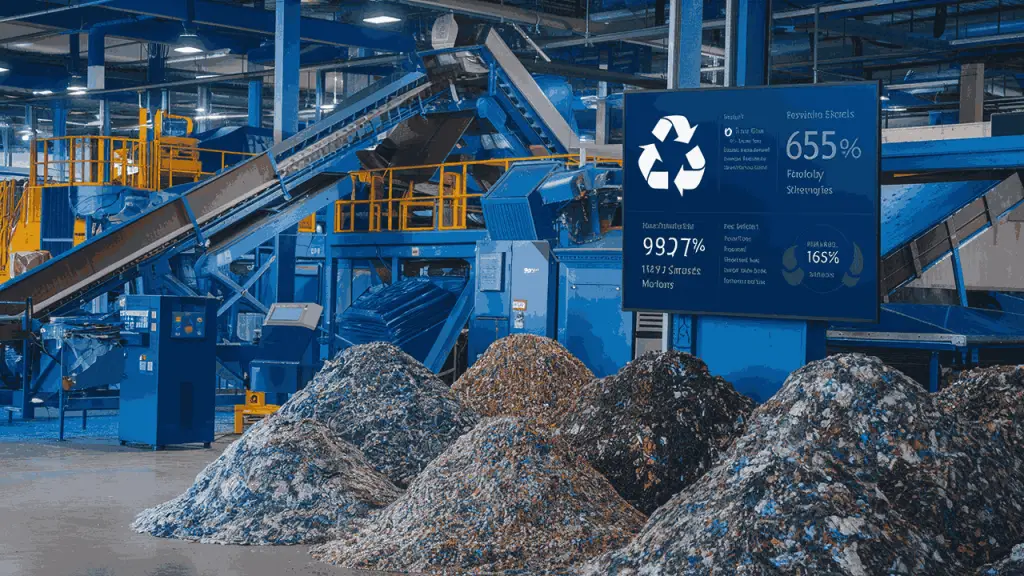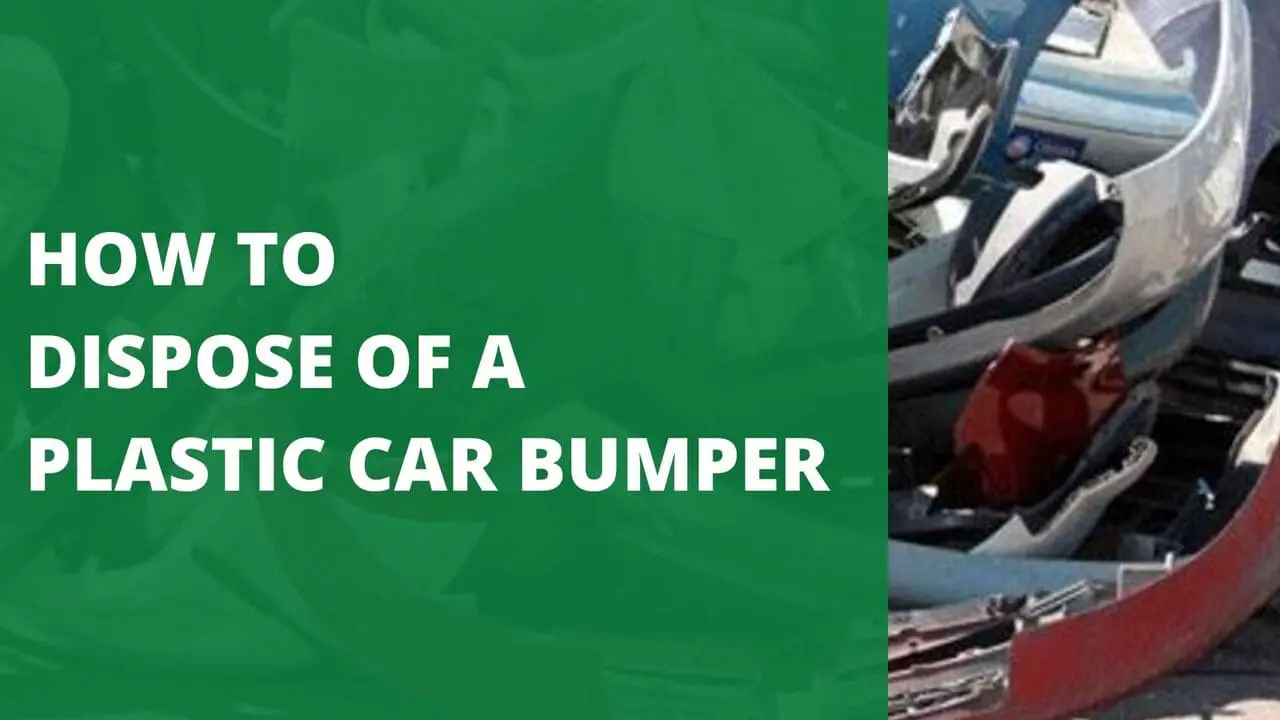Got an old plastic car bumper sitting around and wondering what to do with it. Whether it’s from a car upgrade or a little fender bender, tossing it in the trash isn’t so simple.
In this post, we’ll explore what these bumpers are made of, share fun ways to repurpose them, and show you how to dispose of them in an eco-friendly way.

Understanding Plastic Car Bumpers
A. Composition and recyclability challenges
You’ll find that plastic car bumpers are complex components, weighing about 20 pounds and consisting of a mix of plastics, rubber-like polymers, and additives. This composition enhances durability but poses significant recycling challenges.
Unlike common recyclable plastics, bumpers’ complexity makes them economically unfeasible to recycle through traditional methods.
B. Weight and materials used
Car bumpers contribute to 10%-15% of a vehicle’s weight, primarily composed of polypropylene (PP) and thermoplastic polyolefins (TPO). These materials are chosen for their lightweight properties and impact resistance.
However, their complexity compared to common recyclable plastics creates unique disposal challenges.
| Material | Advantages | Recyclability |
| Polypropylene (PP) | Lightweight, durable | Challenging |
| Thermoplastic Polyolefins (TPO) | Impact resistant | Complex |
With this understanding of bumper composition, next, we’ll explore the various options for disposing of plastic bumpers.
Options for Disposing of Plastic Bumpers

Understanding these options will help you make an environmentally conscious decision when it’s time to part with your old bumper.
A. Recycling facilities and local guidelines
You’ll find that recycling is one of the most eco-friendly ways to dispose of your plastic car bumper. Many recycling centers are equipped to handle large, bulky items like bumpers.
However, it’s crucial to check your local guidelines first. Here’s what you need to know:
- Contact your local recycling facility to confirm they accept plastic car bumpers
- Ask about any preparation requirements, such as cleaning or removing non-plastic parts
- Inquire about drop-off procedures or potential pick-up services
Remember, proper preparation enhances the efficiency of the recycling process, so follow the guidelines carefully. If you’re looking to recycle other car parts, check out our guide on How To Recycle Old Tires [Your Guide To Tire Recycling]
B. Cutting into smaller pieces for easier disposal
If recycling facilities in your area don’t accept whole bumpers, you might need to cut them into smaller pieces. This approach can make disposal more manageable:
- Use appropriate tools to safely cut the bumper into manageable sections
- Ensure you’re following local waste management guidelines for size restrictions
- Be aware that this method may limit recycling options, as it can complicate the sorting process
C. Listing for free on online marketplaces
Your old bumper might be valuable to someone else. Consider listing it for free on online platforms:
- Use sites like Craigslist or local community forums
- Clearly describe the bumper’s condition and compatibility
- Mention that it’s available for pickup to avoid shipping complications
This method not only helps you dispose of the bumper but also extends its life through reuse.
D. Salvaging usable parts before disposal
Before disposing of your bumper, consider salvaging any usable parts:
| Salvageable Parts | Potential Uses |
| Clips and fasteners | Repairs on other vehicles |
| Grilles or mesh inserts | Custom automotive projects |
| Reflectors or light housings | Replacement parts |
By salvaging these components, you’re reducing waste and potentially helping others with their vehicle repairs or projects.
As you prepare to dispose of your plastic car bumper, keep in mind that the automotive industry is making significant advancements in plastic recycling.
In the next section, we’ll explore these innovative developments and how they’re shaping the future of automotive waste management.
Advancements in Automotive Plastic Recycling

End-Of-Life Vehicle Recycling Demonstration Project
The Global Impact Coalition has launched an innovative pilot project in the Netherlands and Germany. This initiative aims to tackle the issue of recycling plastics from End of Life Vehicles (ELVs). You’ll be interested to know that:
- 100 ELVs will be dismantled, shredded, and sorted
- 10 distinct polymer types will be processed
- Less than 20% of ELV plastics are currently recycled
- The project aligns with EU regulations for 2030
Potential uses for recycled bumper plastics
| Manufacturer | Recycled Plastic Usage |
| Volvo | 25% by 2025 |
| Renault | 30% in the Megane II model |
| Ford | Aerodynamics & sound insulation |
With these advancements in mind, next, we’ll explore creative repurposing ideas for your old plastic car bumper.
Creative Repurposing Ideas

These ideas not only give new life to your discarded car parts but also contribute to reducing automotive waste.
A. Decorative use in garages
You can transform your old plastic car bumper into a functional and decorative element for your garage. One practical application is creating a DIY car door protector. Here’s how you can do it:
- Clean and prepare the bumper
- Cut it to an appropriate size
- Secure it to your garage wall
This repurposed bumper acts as a cushion, preventing your car doors from hitting the wall when opened in tight spaces. It’s an excellent way to protect both your vehicle and your garage walls.
| Materials Needed | Tools Required |
| Old plastic bumper | Saw or cutting tool |
| Screws or strong adhesive | Drill (if using screws) |
| Cleaning supplies | Measuring tape |
B. Potential DIY projects
Your creativity is the limit when it comes to repurposing plastic car bumpers. Here are some innovative DIY project ideas:
- Outdoor planters: Cut the bumper into sections and use them as unique, weather resistant planters for your garden.
- Garage organizers: Create custom storage solutions for tools or sports equipment.
- Sledding boards: Transform a smooth section of the bumper into a fun sledding board for winter activities.
For those who enjoy hands-on projects, you can even use your old bumper to practice automotive repair techniques. Here’s a simplified process for reshaping plastic:
- Soften the plastic using boiling water or a hair dryer
- Gradually reshape the material using wooden tools
- Allow it to cool and harden in the desired shape
This DIY approach not only saves you money but also provides a satisfying learning experience in automotive repair.
With these creative repurposing ideas next, we’ll explore the environmental considerations of disposing of plastic car bumpers. It’s crucial to balance creativity with eco-friendly practices to ensure responsible automotive waste management.
Environmental Considerations
A. Diverting bumpers from landfills
You can significantly reduce plastic waste by choosing responsible disposal methods. Recycling centers, auto repair schools, and charities offer eco-friendly alternatives to landfills.
By donating or recycling your bumper, you’re contributing to resource conservation and reducing pollution.
B. Increasing recyclability of new vehicles
| Sustainable Design Innovations | Benefits |
| Bio-based materials | Biodegradable end-of-life solutions |
| Modular designs | Minimizes waste by replacing only damaged sections |
| Advanced digital technologies | Improves material efficiency and reduces carbon footprint |
You’ll be pleased to know that manufacturers are adopting these innovations to enhance vehicle sustainability. As we move forward, preparing your bumper for disposal is crucial for effective recycling.
Preparing Bumpers for Disposal

Now that we’ve covered the environmental considerations of disposing of plastic car bumpers, let’s focus on how to prepare these bumpers for proper disposal. This critical step ensures that your car parts are handled responsibly and in an eco-friendly manner.
1. Checking for recycling symbols
Before you begin the disposal process, it’s essential to examine your plastic car bumper for recycling symbols. These symbols can provide valuable information about the type of plastic used and its recyclability. Here’s what you should look for:
| Symbol | Meaning | Recyclability |
| 1-7 | Plastic resin code | Generally recyclable |
| ♻️ | Universal recycling symbol | Recyclable material |
| Not required | No symbol present | Check with local services |
By identifying these symbols, you can better understand how to proceed with the disposal process.
2. Contacting local waste management services
Once you’ve checked for recycling symbols the next step is to reach out to your local waste management services. This is crucial because disposal regulations can vary by location. Here’s what you should do:
- Look up your local waste management office’s contact information
- Inquire about their specific guidelines for automotive plastic disposal
- Ask if they have special collection days for car parts
- Determine if they require any preparation of the bumper before collection
Remember, some services may not accept car bumpers, so it’s essential to confirm before proceeding.
3. Proper cutting techniques for recycling
If your local waste management service accepts car bumpers but requires them to be prepared in a specific way, you’ll need to know the proper cutting techniques. This step is crucial for ensuring that your bumper can be efficiently recycled. Follow these guidelines:
- Use appropriate safety gear including gloves and safety glasses
- Employ sharp cutting tools designed for plastic materials
- Cut the bumper into manageable pieces as specified by your local recycling center
- Remove any metal attachments or non-plastic components
- Ensure all cuts are clean and free from jagged edges
By following these steps, you’re not only making the recycling process more efficient but also contributing to more effective automotive waste management.
Conclusion
Getting rid of a plastic car bumper the right way isn’t just easy, it’s good for the planet too. You’ve got options like recycling or even turning it into something cool.
Just check for recycling symbols, call your local center, or maybe give it away online. Every little bit you do helps keep junk out of landfills and makes the future a little greener.

